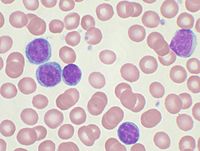
Photo from wikipedia
We thank the authors for their interest in our Editorial. With their letter, they point to the relevance of IGHV analysis in chronic lymphocytic leukemia (CLL) patients in the context… Click to show full abstract
We thank the authors for their interest in our Editorial. With their letter, they point to the relevance of IGHV analysis in chronic lymphocytic leukemia (CLL) patients in the context of different ethnic groups other than Caucasians, as exemplified in the Editorial by the paper from our group that compared the IGHV gene usage and stereotypy of 623 Chinese and 789 Italian CLL. Amato et al. raised the issue of African CLL. It is known that CLL has a lower incidence and a more aggressive course in Africa than in Western countries. Amato et al. compared the IGHV usage in 25 Senegalese and 50 Italian CLL patients, showing that IGHV1 (IGHV1-69), IGHD3 and IGHJ6 were significantly more frequent in Senegalese patients, whereas IGHV3-30 was common and limited to Italian cases. No major B-cell receptor (BCR) stereotypes were identified among Senegalese CLL. With these results, they propose a biological explanation for the earlier onset of the disease and the more aggressive clinical behavior of Senegalese CLL compared with Italian patients. The authors also argue that a chronic antigenic stimulation (i.e. malaria) can be a pivotal driver of malignant cells in the pathogenesis of African CLL. Their effort is commendable, given the few data on the IGHV repertoire of African CLL. However, their observations need to be taken with great caution given the very limited number of examined patients, the significantly different M/F ratio between the two cohorts, with men almost exclusively represented among African patients, and the bias induced by the lack of access to health care facilities that may have influenced the advanced clinical stage shown by Senegalese patients. The suggestion that CLL in African patients is more aggressive than in Caucasian patients is supported by different series from various African states, all describing how African CLL patients usually present with advanced stages and symptomatic disease. Moreover, this observation holds true even within the US SEER data, that compare African American CLL with Caucasian CLL patients, suggesting the influence of a genetic background on the disease course. Unfortunately, the very limited number of published cases does not allow to draw any firm conclusion on the IGHV repertoire in the African population. Even less when analyzing the stereotyped BCR. Data from MDACC seem to confirm a higher proportion of unmutated IGHV among 85 African American CLL compared with Caucasian CLL patients. There are also other very interesting papers that could be cited, such as those demonstrating a lower incidence of CLLlike monoclonal B-cell lymphocytosis (MBL) among African American CLL women, or among Ugandan volunteers compared to age and sex-matched British individuals. Finally, the frequency of single nucleotide polymorphisms known to confer a risk of developing CLL in Caucasians seems lower in African Americans. The paper by Baliakas et al., as well as our Editorial, were focused on the prognostic and pathogenetic implication of IGHV in CLL, achieved in the last 20 years mainly through the analysis of Caucasian patients. We agree that many other aspects of this topic could be discussed, such as indeed ethnicity and the genetic and antigenic pressure as the factors that shape CLL incidence and clinical behavior across different populations, but they were beyond the scope of our Editorial. Our data on Chinese CLL seems to suggest that any given IGHV gene tends to maintain the percentage of mutations, the tendency to a BCR sterotypy and the clinical impact across the populations. What varies is the frequency of each given IGHV gene. Whether this holds true among African or African American CLL patients will need to be addressed on larger series of patients.
Journal Title: Haematologica
Year Published: 2019
Link to full text (if available)
Share on Social Media: Sign Up to like & get
recommendations!